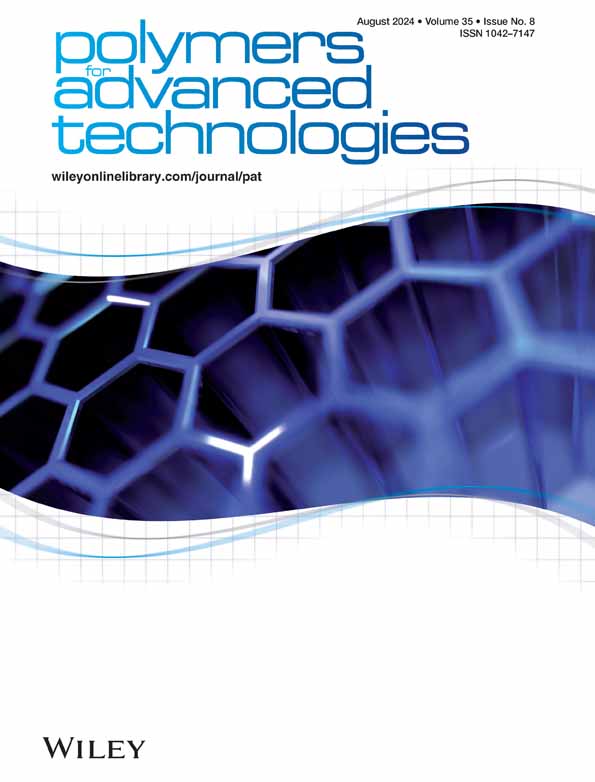Plasma treated‐double layer electrospun fiber mats from thermoplastic polyurethane and gelatin for wound healing applications
IF 3.4
4区 工程技术
Q2 POLYMER SCIENCE
引用次数: 0
Abstract
Conventional wound treatment options provide a barrier against exogenous microbial penetration but cannot simultaneously provide an antibacterial characteristic and promote healing. However, bioactive dressings can accelerate wound healing and have an antibacterial effect in addition to being able to cover and protect lesions. In this study, double‐layer thermoplastic polyurethane (TPU)‐gelatin fibrous dressings that mimic the epidermis and dermis layers of the skin were fabricated via electrospinning technique. As a bioactive agent,用于伤口愈合的热塑性聚氨酯和明胶等离子处理双层电纺纤维毡
传统的伤口处理方法可以阻挡外源性微生物的侵入,但无法同时提供抗菌特性和促进伤口愈合。然而,生物活性敷料除了能覆盖和保护病变部位外,还能加速伤口愈合并具有抗菌效果。本研究通过电纺丝技术制造了双层热塑性聚氨酯(TPU)-明胶纤维敷料,模拟了皮肤的表皮层和真皮层。金丝桃油(HPO)作为一种生物活性剂,可赋予敷料抗菌和治疗特性。纤维毡配方中还使用了单宁酸作为交联剂。氧等离子处理是一种表面活化技术,可提高热塑性聚氨酯和凝胶层的粘附性。扫描电子显微镜(SEM)研究揭示了纤维毡的纤维结构。傅立叶变换红外光谱(FTIR)用于证明垫子上的 HPO 负载。将垫子的水蒸气透过率(WVTR)和液体吸收率与一些商业敷料进行了比较。根据这些结果,可以认为敷料垫可用于中度至高度渗出性伤口。由于含有单宁酸,所有敷料,甚至是对照样本,都显示出对金黄色葡萄球菌和大肠杆菌的抗菌特性。对血浆处理过的样品进行了体外伤口愈合试验,结果表明该样品不会对伤口愈合所需的细胞迁移和增殖能力产生负面影响。总体结果表明,经等离子体处理的纤维垫可作为具有抗菌特性的伤口敷料。
本文章由计算机程序翻译,如有差异,请以英文原文为准。
求助全文
约1分钟内获得全文
求助全文
来源期刊

Polymers for Advanced Technologies
工程技术-高分子科学
CiteScore
6.20
自引率
5.90%
发文量
337
审稿时长
2.1 months
期刊介绍:
Polymers for Advanced Technologies is published in response to recent significant changes in the patterns of materials research and development. Worldwide attention has been focused on the critical importance of materials in the creation of new devices and systems. It is now recognized that materials are often the limiting factor in bringing a new technical concept to fruition and that polymers are often the materials of choice in these demanding applications. A significant portion of the polymer research ongoing in the world is directly or indirectly related to the solution of complex, interdisciplinary problems whose successful resolution is necessary for achievement of broad system objectives.
Polymers for Advanced Technologies is focused to the interest of scientists and engineers from academia and industry who are participating in these new areas of polymer research and development. It is the intent of this journal to impact the polymer related advanced technologies to meet the challenge of the twenty-first century.
Polymers for Advanced Technologies aims at encouraging innovation, invention, imagination and creativity by providing a broad interdisciplinary platform for the presentation of new research and development concepts, theories and results which reflect the changing image and pace of modern polymer science and technology.
Polymers for Advanced Technologies aims at becoming the central organ of the new multi-disciplinary polymer oriented materials science of the highest scientific standards. It will publish original research papers on finished studies; communications limited to five typewritten pages plus three illustrations, containing experimental details; review articles of up to 40 pages; letters to the editor and book reviews. Review articles will normally be published by invitation. The Editor-in-Chief welcomes suggestions for reviews.
 求助内容:
求助内容: 应助结果提醒方式:
应助结果提醒方式:


